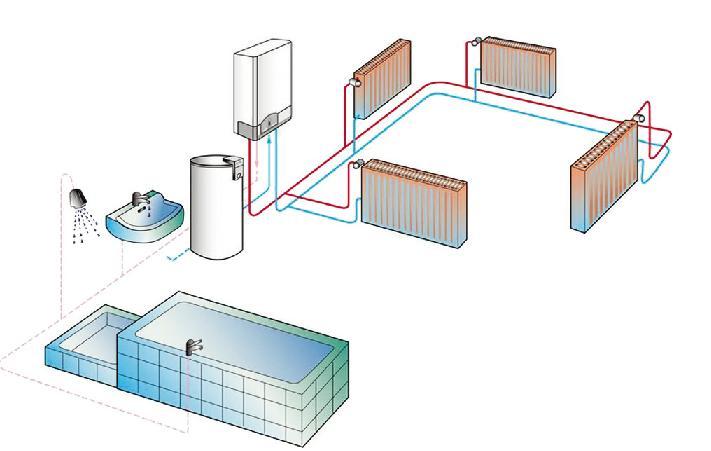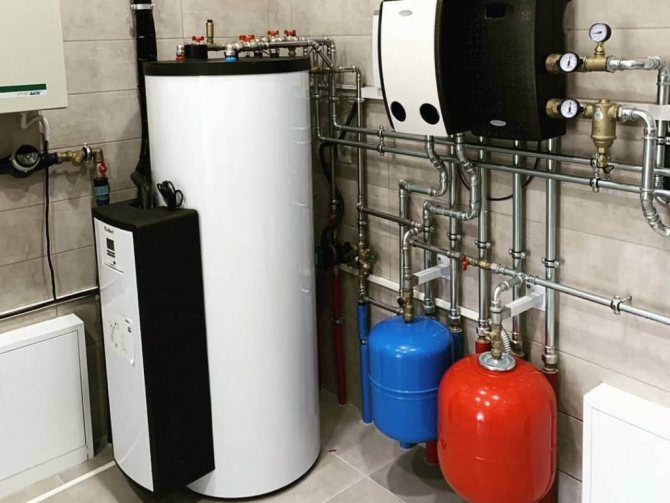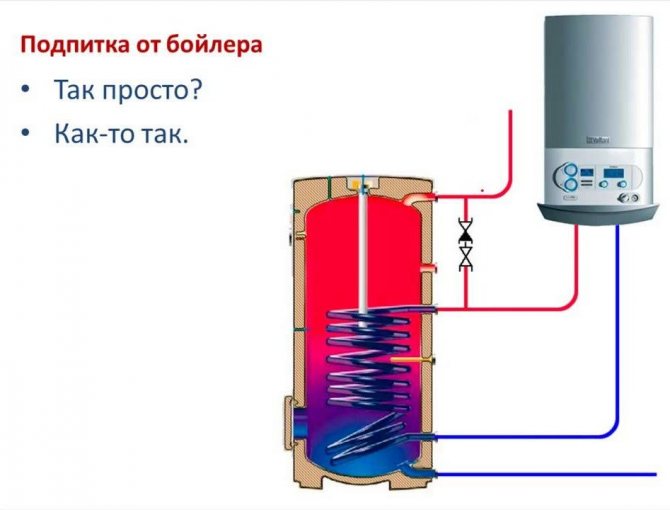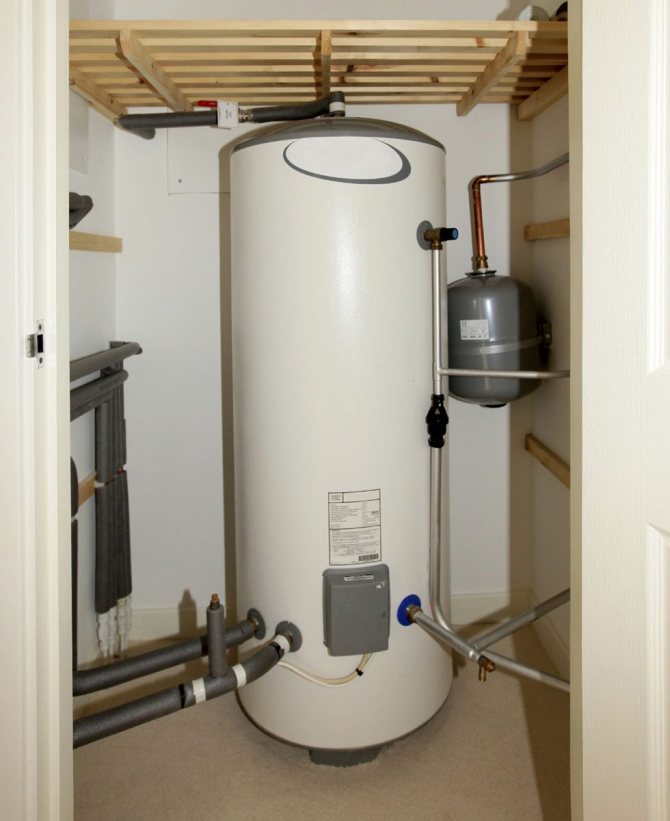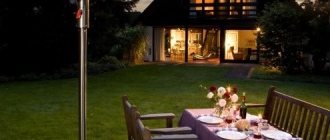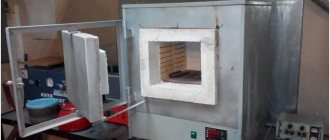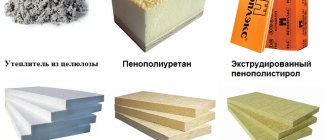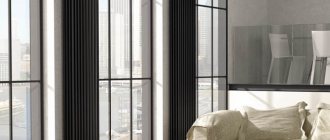Rating: 1 920
So, in the house Jack built, there was wheat, a cat, a dog, a titmouse and a basement. Only nothing is known about the heating system, whether there was gas or electric heating in a private house. And to this day, many homeowners do not know what to choose. Of course, there are heating boilers, but this device is not suitable for everyone, because it is quite expensive. However, there is a cheap alternative - a boiler.
Of course, it also has drawbacks - it is not always possible to use an electric boiler, you need to create conditions for its operation. But often electric heating with a boiler is more efficient than using a boiler. Heating with a boiler is connected to several pipes. The two main ones go to the radiator through the collectors with water supply: one through the cold, the other through the hot.
Boiler features
If a person wants to install heating in his private house, operating with a boiler, then he must know what kind of design this device has, what are its features.
The main part of this device is the storage tank. It is in it that the heating medium is heated, i.e. water. To improve the performance of the system with the most suitable temperature regime, you should purchase a storage tank with a large volume.
In the tank itself, a heating element is installed for heating, which will heat the water to the temperature that is needed. Automation controls this device. When the water reaches a certain temperature threshold, the machine will turn off the heating element. Currently, storage tanks are placed in a housing that serves as additional protection. To ensure thermal insulation during the production of tanks, material is placed between the walls of the tank and the body. Therefore, the heat will not come out.

Boiler design
What is a boiler for heating an apartment or a private house
It is a standard device originally designed to provide hot water supply (DHW), which was later adapted to perform an additional function - maintaining a comfortable temperature in rooms. Some manufacturers produce models that are immediately tailored to the task, but conventional equipment may also work for this. It is especially economical to use an old heater, which, if properly equipped, will be able to replace a heating boiler.
Flow type heaters
A water heater powered by electricity is a separate category that differs in design from other devices that accumulate and heat water. Firstly, the device is smaller in size, because there is no drive in it. The inlet pipe serves to drain water into the apparatus, where it is heated.
Water heater
A copper flask is used for heating, which produces a powerful heating element. For flow-through devices, heating elements of various powers are used: 5-25 kW. After heating, the coolant will enter the electrical heating system. And special control valves control the level of water flow.


Instantaneous water heater
Boiler
The advantage of this device is that it heats up the water in a significantly short period of time. But many people say that this device consumes a lot of electrical energy. Therefore, these units are used when they install a heating system in houses with a small area, for example, for different types of summer cottages. Therefore, they calculate in advance what power the boiler should have.In accordance with these calculations, such wiring is installed so that it can withstand the necessary loads.
Is it profitable to use a boiler
Almost any idea is a double-edged sword, so it is worth considering both the pros and cons of its implementation. Benefits first
- Low organization costs. A water heater is an order of magnitude cheaper than the simplest low-power boiler for a complete set. If it is supposed to use the old unit, then the costs are generally reduced to a minimum.
- The possibility of self-assembly. Subject to the following recommendations, you can install and connect heating and hot water using a boiler without the involvement of third-party specialists.
- Efficiency. Due to the fact that all heaters are equipped with a layer of insulation, the water stays hot longer than in the boiler. As a result, heat loss is reduced.
- Compactness. Some boiler models are horizontally oriented, so they can be suspended from the ceiling.
Among the disadvantages of such a heating system, it is worth noting
- possibility of use only for premises limited in area
- high degree of wear and corrosion of equipment, since initially the boiler was not intended to be installed instead of a heating boiler
- significant time and labor costs for alteration of the device, retrofitting of the complex with the necessary elements
How to choose a boiler
The device is chosen, as you know, so that it heats water. And also it must be suitable for electric heating of a private house. Therefore, they study all the functions and capabilities of such an apparatus. The first thing to consider is the power of the heating element installed in the heater. The more power, the more efficiently the device will provide heating.


Varieties of boilers
Capacities are different. The first category is parameters from 1.5 to 3 kW. These devices are used more for household needs. The second category is up to 12 kW. It includes professional devices. These boilers differ in that a low-power one works all the time, and devices with a higher power are automatically controlled, turned off when the water reaches the desired temperature.
It is imperative to study what volumes of tanks are. This is a very important nuance that cannot be ignored. After all, how long the storage tank will work depends on the volume of the tank. After all, the heating device will be able to stay in rest mode longer if the volume is larger. Thus, the consumption of electricity will become less, respectively, the expenses for its payment will also decrease.
It is best to choose a device with a tank volume of 300 liters. Of course, it is expensive, but it will pay off in subsequent operation.
However, the larger the volume of the tank, the longer it will take to heat up. For example, if the volume is 10 liters, then it will heat up within half an hour. But a 200-liter device will heat up for 6 hours. The water is heated on average up to 85 ° C, after which the automation will maintain the temperature at the set level. If the tank is made in the same way as a thermos, i.e. has thermal insulation, then the energy consumption will decrease. Basically, in cities there is a certain tariff, so if a larger boiler is used, then it is better to heat it at night.
Types of water heaters
To determine which device is optimal for performing the heating function, you need to understand their types and features of work.
Flowing
This is an extremely compact equipment designed most often for servicing 1-2 points of disassembly (washing, shower). The water is heated continuously as the working medium flows through the heat exchanger. The storage tank is not included in the package of the device, which determines its rather limited capabilities to cover the needs for hot water supply.Due to insufficient power, the instantaneous boiler cannot be used to heat water from the heating system.
Cumulative
Unlike the previous type, they are equipped with a container in which a resource reserve is created to meet almost unlimited needs for hot water supply. However, not all equipment models can be adapted for space heating. There are three main types of storage boilers: gas, indirect, electric.
Devices of the first type are rarely used in practice due to the inconvenience of connection. For their work, it is necessary to arrange a chimney, supply and exhaust ventilation. Than using them for heating, it is easier to install a full-fledged gas boiler.
Indirect boilers are completely dependent on the operation of the main heat generator, to which they are connected through a pipeline. It connects to a spiral coil located inside the tank. Indirect water heaters cannot be used for autonomous heating, since they are not an independent unit that generates energy.
Only the third type - electric boilers can fully cope with the functions of the boiler, subject to some refinement. This equipment operates from the network, to which it is connected through the heating element. The power of this element can be enough to heat a small area. In this case, the liquid heated in the tank will be used as a heat carrier circulating through the pipes of the system.
Installation of equipment
If earlier the choice of devices for organizing heating was not very large, now the range of offered devices is very diverse. The loads on the network are different, and you can pick up such a water heater so that it can cope with them. The size and volume of tanks varies.


Heating system diagram with a boiler
Various combinations are used for water inlet and outlet. It is best if the outlet of the coolant is from the top, and the inlet is from the bottom. The water will heat up, enter the heating system, and will not mix with cold water. There are outlet pipes in the boiler. Their diameter should be 2 inches so that you can connect the device to the pipes of the heating system without using adapters.
It is worth knowing that the inlet and outlet diameters of most of the devices on the market today are 3.54 inches. Therefore, it is difficult to attach radiators to them. And the calculation of power is simple: for 10m2 - 1kW.
If the area near the house is small, then household water heaters are used for the heating system. But at the same time, the power of the heating element should not be less than 10 kW. Low-power appliances (from 5 to 7 kW) are used for minor needs - for example, organizing a shower.
Pay attention to the instructions, which contain all the necessary tips for installing the heater. It is necessary to strictly follow them so that the installation is correct, and in further work there are no unforeseen disruptions.
Important! Pipes and heating radiators are taken into account, or rather, how many elbows, branches, where they are located.
The performance of electric heating of a private house depends on this. For optimal performance, the number of all these branches and elbows should be as small as possible.
It is clear that warm air will escape from the room. This can affect the load of heating elements. Therefore, before the design of the system and installation, the house is insulated. All installations must be looked after and do not forget about preventive maintenance. It is imperative to call a specialist for maintenance of the heating system before the onset of cold weather. Of course, the owner can inspect and service all the parts himself, but he must have at least minimal knowledge about the operation of boilers and heating elements.


Boiler piping example
Indirect heating boiler
An acceptable alternative to the above-described method of heating rooms with a boiler is indirect heating tanks. By the principle of operation, they are similar to the classic ones, but with one exception - a serpentine tube is located inside, which is connected to the heating system.
But how can such a water heater be used for heating? First, it should be remembered that it is only an additional source of heating the coolant. The main boiler is any type. For efficient operation of the indirect heating boiler, it is recommended to install it in front of the return pipe inlet to the boiler. Heat from the hot water supply will be transferred to the coolant in the coil. Thus, you can make the optimal temperature regime of the system.
They differ from electric water heaters for heating, type BEO, in low efficiency as the main source of heat generation. But this way it is possible to reduce the current costs of the energy carrier. When choosing an indirect heating boiler, it is recommended to pay attention to these parameters.
- The volume of the container. The area of contact of hot water with the coil depends on it. The larger it is, the more the coolant will heat up. The optimal volume should be 150 liters or more;
- Power of heating elements. Directly affects the rate of water heating. On average, for every 50 liters of volume, a power of 2 kW is required;
- Thermal insulation of the case. To minimize heat loss, it is better to choose models with a double wall, inside which there is a heater.
However, when organizing heating with a water heater of this type, the high cost should be taken into account.
For example, the popular Vaillant uniSTOR VIH R model with a volume of 200 liters will cost almost 20 thousand rubles. But this will be a better option than using a conventional water heater for heating.
The composition of the device, its parameters
The boiler consists of the following elements:
- Tank.
- Heating element.
- Anode (needed to prevent corrosion).
- Thermal insulation (keeps water warm).
- Thermostat (use it to set the desired temperature).
- Outer casing (the type of device depends on it).
- Safety valve (needed to relieve excessive pressure).
The parameters of the device include:
- The material used for thermal insulation (mineral wool, polyurethane, polyurethane foam).
- Volume.
- Tank coating (enamel, steel, glass porcelain).
- Location option (vertically, horizontally, next to the sink).
- Heating element power.
- Is the coil built-in (if yes, the boiler can be connected to the boiler).
- Anode material (magnesium, titanium).
How is boiler efficient heating installed?
First of all, a place is chosen to place the drive. Depending on the features of the model and the volume of the tank, it can be installed on the wall on special brackets or on the floor. In the latter case, it is better for him to prepare a base covered with insulation. So it will cool down more slowly, and the energy will not go to heating the supporting surface.
The return line is connected to the upper connector, the system supply line to the lower one. All connections are best done using stop valves, which allows you to quickly cut off equipment for repair or replacement. Before entering the tank, a filter is installed to remove large insoluble impurities from the coolant, as well as a check and safety valves. The first is necessary to prevent leakage of the working medium, the second is to relieve pressure.
Any water heater powered by heating will not be able to perform its function normally without a circulation pump. It cuts into the return line and provides a forced movement of the coolant in the desired direction. It is also advisable to install an expansion tank to protect against water hammer.
The scheme of organization of the complex is shown in maximum detail in Figure 1.


Fig. 1
Flowing or storage
Instantaneous water heaters are usually attached to the wall.They are not large, so it is necessary to find a place for it that meets the safety conditions. Flow type heaters are low cost, convenient and economical. But there is one significant drawback: the lack of the ability to produce a large flow of hot water. If large volumes are required, this type of boiler is not suitable for a private house.
With a large consumption of hot water per day, the best choice will be devices with storage tanks that provide a good pressure of hot water. But the price of such a water heating system is quite high.
Boilers are susceptible to damage to parts inside the structure. At the same time, the tanks are steel and cast iron.
No. 4. Boiler tank shape
When deciding which boiler to choose, you can get so carried away by studying the data on power, volume and material that you forget about much more obvious things. It's about the shape of the case. There are not many options here, the case may be:
- round;
- rectangular.
Boilers with a round barrel-shaped bodytend to be cheaper (as they are easier to manufacture) but take up more space. This is the most popular design option. Devices with rectangular tank will save space, since they can be installed in a corner, niche, on the edge of a wall, or even completely hidden in a cabinet. Moreover, due to their shape, such models are equipped with a thicker layer of thermal insulation. There are also so-called slim modelsin which the diameter or one of the sides is smaller than in standard devices. It is very important to decide before buying exactly where the boiler will be located, and how much space is available for its installation.
As for colors, then there are few options. The most popular and safe option is the white case. Also in demand are gray and silver models.
Rating of the best models of electric boilers for the home
Protherm Skat RAY 12 KE / 14
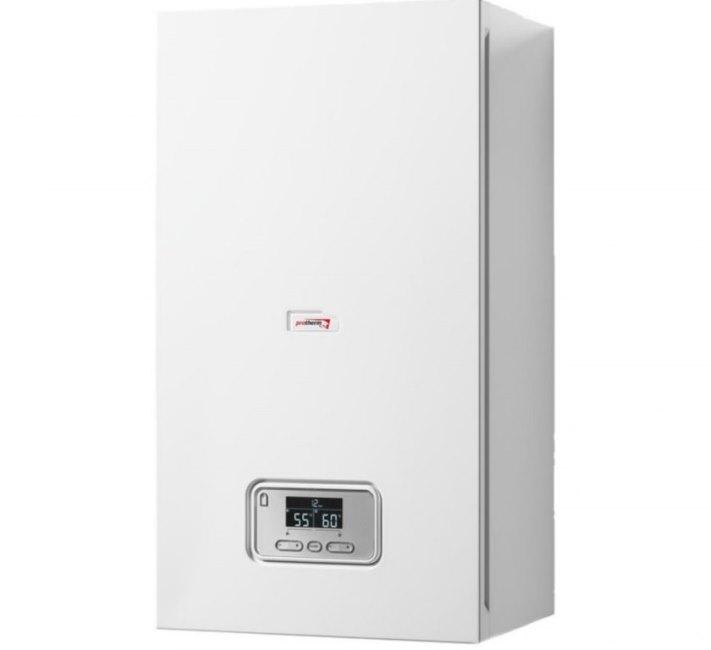

These products are distinguished by a very high efficiency - this indicator for the boiler reaches 99.5%, and both water and antifreeze can be used as a heat carrier. The design is absolutely safe due to the use of a large number of newest and original solutions: a thermal fuse is installed here, frost protection is provided, there is a pump protection against overheating and against idling. In general, the brand of these boilers has long been successfully proven by the Russian consumer. The model is produced in eight modifications, differing from each other in terms of power - from 6 to 28 kW. The boiler has a storage boiler. Despite the fact that it belongs to a single-circuit product, some water can be heated in it. It is possible to connect a room regulator, after which the system will automatically maintain the most comfortable temperature at home.
The case has a liquid crystal and very informative display. The controls are intuitive, so you will be able to figure it out quickly enough. The boiler does not need to be connected to a chimney, it operates from a standard household power supply. It does not require any special skills for service. The products are very reliable, since they have a self-diagnostic system, there are a large number of sensors that check the performance of all elements of the equipment. The boiler has a circulation pump and an expansion tank, so they do not have to be installed outside the device.
Benefits:
- Works absolutely silently;
- All parameters are maintained stably;
- High efficiency;
- Long service life;
- Reliability;
- Takes up the minimum amount of free space;
- There is an informative display.
Disadvantages:
- The thermostat is not included in the kit, you will have to purchase it separately.
9. Vaillant eloBLOCK VE 9
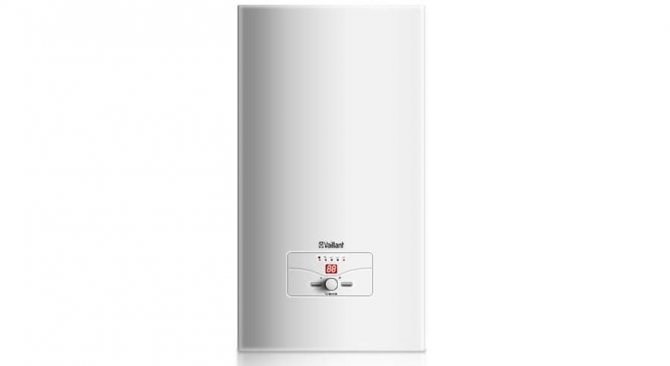

This equipment is perfect for the manufacture of an individual heating system in a private house. The boiler has a high power, due to which the room heats up to the set temperature in just a few hours. It is allowed to use it not only for residential, but also for industrial premises, the area of which is no more than 120 square meters.
If necessary, it can be connected to the underfloor heating system; it is possible to connect a storage boiler. The body is made of stainless steel sheet. On its front side there is a convenient and most understandable external control panel equipped with an LED display, where you can easily adjust the temperature regime. The design provides a powerful and efficient microprocessor, which ensures the accuracy of all changes in the heating system.
More: TOP-10 best music centers with karaoke
To extend the service life of the unit, the manufacturer has equipped it with a number of protective systems - protection against overheating, against too high pressure in the system, against freezing, etc. The power changes smoothly, which prevents overloads. The kit includes an external temperature sensor that will transmit data to the microprocessor. He, in turn, will increase or decrease the temperature of the coolant.
Benefits:
- Significant heating area;
- Possibility of connection to the "warm floor" system;
- You can additionally purchase a boiler for hot water;
- The expansion tank is equipped with a mechanical pressure gauge;
- Powered exclusively by 200 V.
Disadvantages:
- Expensive service;
- High price.
EVAN Next 5


It can be used for heating not only private houses, but also summer cottages, warehouses and even small retail premises. Often, some people purchase such products as a backup heat source if a solid fuel or gas appliance is installed as the main one. By and large, such a boiler is a monoblock, where controls are located under one body, all the necessary automation, including an expansion tank and a circulation pump. A built-in thermostat is provided, due to which the temperature of the coolant can be in the range from 30 to 85 degrees. Three-stage equipment power control. In order to ensure maximum safety when heating the coolant to the set temperature, the thermostat turns off the power to the device, and when the temperature drops below the set limit, it will restart the device.
In order to additionally protect the device from overheating, it has a built-in self-resetting emergency thermal switch. It is triggered when the temperature in the system rises to 92 degrees. The heating element is made of stainless steel, which greatly extends its service life. The design of the heating element is block, so this part is very easy to replace if necessary If desired, the boiler can be connected to a water-heated floor system, as well as a unit that provides remote control of this device.
Benefits:
- Acceptable cost of the unit;
- Very high quality components and assembly;
- It is possible to install additional elements;
- Automation works instantly;
- Can be connected to the underfloor heating system.
Disadvantages:
- The case is quite easily soiled - fingerprints and dust are visible on it.
EVAN EPO 4
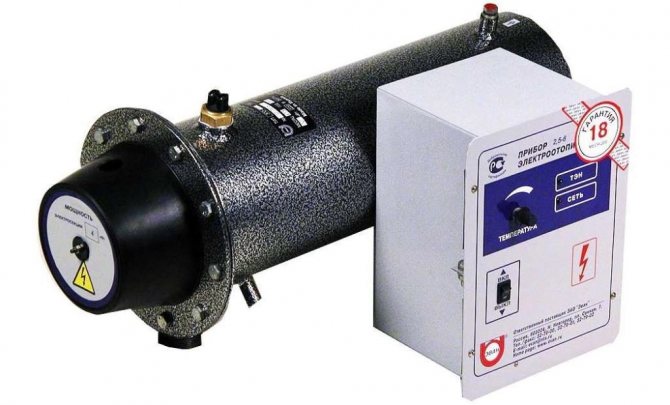

These products are domestically produced, one of the most budgetary models presented in our rating of the best electric boilers. The main distinguishing feature of the unit is the absence of a body, but at the same time it retains all the basic qualities and functions. The temperature range is from 30 to 85 degrees - which is quite enough even for the most severe climatic conditions.If necessary, an external thermostat with a remote control module can be connected to the device, but it will have to be purchased separately.
The thermostat is automatic - it is triggered when the coolant temperature drops below the set one. There is an overheating protection system: the boiler will turn off when the water heats up to 92 degrees. Teng is made of thick-walled stainless steel, characterized by a long service life. The device weighs only 15 kg, the maximum pressure in the system is about 4.5 bar, it is designed for connection to a single-phase line with a voltage of 220 V.
Benefits:
- Reliable stainless steel heating elements;
- Does not require maintenance during the entire period of operation;
- Simple device;
- Low price.
Disadvantages:
- The need to purchase additional devices such as a thermostat;
- Lack of housing.
RusNIT 209M
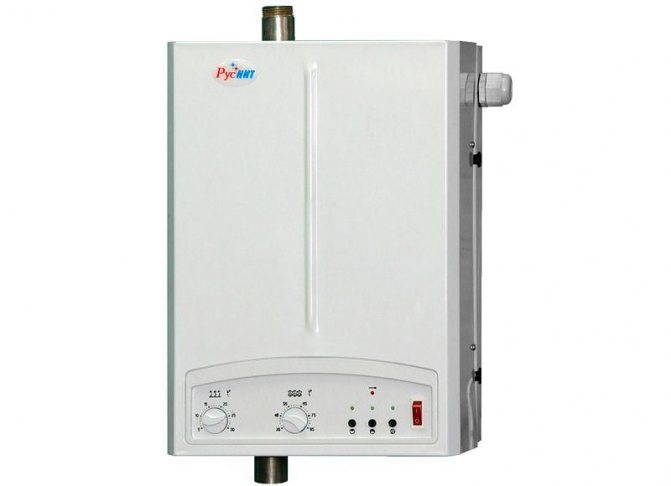

Medium power equipment - consumes only about 9 kW, takes up little space, is attached to the wall. The boiler can be used both for heating and for hot water supply due to the additional installation of a boiler. When installing heating equipment, you will have to install an expansion tank and a circulation pump, since these elements are absent in the boiler.
There is a reliable and durable automation that allows you to maintain a comfortable temperature in the room - no more than 30 degrees. The temperature sensor can be placed both near the unit and at a distance of up to 10 meters. There is a step power adjustment - 30, 60 and 100%. The heating element and the heat exchanger are made of high quality stainless steel; water or antifreeze can be used as a heat carrier. The communication of heating elements is carried out using semiconductor structures, which increases the resource of the device, allows it to work completely silently. When turned on, the contacts do not burn and there is no interference. The boiler is absolutely safe, it has several sensors that monitor the status of the main systems.
More: TOP-10 construction mixers, how to choose?
Benefits:
- Withstands low voltage perfectly - up to 20%;
- Comes with a temperature control sensor;
- The control is on the remote elements;
- Works smoothly;
- Heated area up to 65 square meters;
- Nice appearance and small overall dimensions;
- Connects to both single-phase and three-phase networks;
- The pump can operate in both automatic and forced mode.
Disadvantages:
- The magnetic starter buzzes a little, the issue is solved by adjusting the device;
- Difficult to connect due to confusing locations of phase, zero and ground.
ZOTA 9 Lux


The boiler is designed quite simply, which makes it easier to install and connect, and even with the equipment of the underfloor heating system, there is no need to install additional control valves. The unit weighs a little and has small overall dimensions, easy access to heating elements, due to which the boiler maintenance becomes much easier. The boiler has convenient connectors for all electronic units.
The device is equipped with a large number of fairly accurate sensors, if necessary, you can connect a weekly thermostat to use the equipment in a fully automatic mode. It has a self-diagnosis system, internal memory for individual settings. In such boilers, you can use the GSM module, due to which all basic operations will be carried out from a mobile phone. The boiler is very reliable, all heating elements are made of stainless steel tubes with a diameter of 7.4 mm.
Benefits:
- Reliable overheating protection system;
- The set includes a room thermostat;
- Small size;
- Ease of installation.
Disadvantages:
- Slightly noisy during operation;
- The design does not provide for an expansion tank and circulation pump.
ZOTA 12 Econom
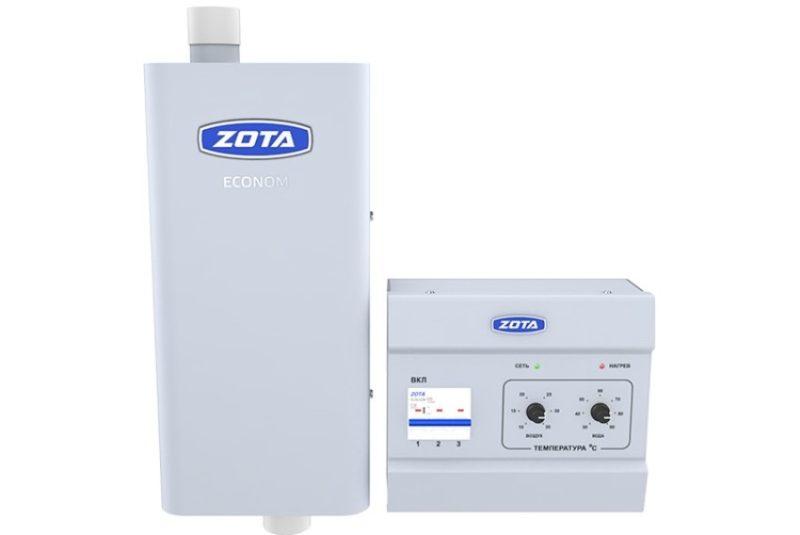

It allows you to provide a sufficient amount of heat for residential and industrial premises, the area of which does not exceed 480 sq. m. These products are suitable for systems with natural and forced circulation of the heat carrier. The boiler is single-circuit - not designed to supply hot water to the water supply system. It takes up the minimum amount of free space in the room. The heating elements are made according to the original technology, they are made of stainless steel tubes, they withstand well any thermal load. The boiler and the device control unit are housed in different housings. The control panel can operate both on power relays (they operate absolutely silently), and on magnetic starters, depending on the model modification of the device. In addition, the products are manufactured in different power options - from 3 to 15 kW.
A sensor can be built into the control panel of the device, which provides automatic regulation of the air temperature in the room within the range from +10 to +35 degrees. The coolant temperature at the outlet of the boiler is in the range from +40 to +90. There are also automatically switched power stages, due to which the consumed electricity is consumed more economically. The boiler is equipped with a system of automatic diagnostics and rotation of heating and power elements.
Benefits:
- Suitable for absolutely any heating systems;
- Stylish appearance;
- Long service life;
- High quality components;
- Convenient and simple control;
- Reliability and efficiency of the device.
Disadvantages:
- When the pressure in the forced-type system decreases, it starts to hum a little.
Reko 6P


It was developed to create comfortable conditions for staying in industrial and residential premises, the area of which does not exceed 60 sq. m. The products are absolutely environmentally friendly, during operation they do not emit combustion products, therefore the probability of carbon monoxide poisoning is zero. The boiler can operate from various networks - 220 and 380 V. Power regulation is carried out both in manual and automatic modes. The electric boiler is also characterized by an attractive and stylish appearance. This is a fairly reliable design - the expansion tank and all heating elements are made of high quality stainless steel. The functionality has been expanded: it is possible to program the operating schedule of the device for a whole week, and an energy consumption meter is also installed in it, so the consumer will always be aware of how much electricity this heater has consumed.
More: Top 10 Best Induction Hobs of 2020
The heating elements are switched here thanks to semiconductor systems, which have a significant service life, function absolutely silently, no burning of contacts and radio interference were detected. Power regulation occurs without phase imbalance. All elements function normally even at reduced voltage. The boiler can be built into the underfloor heating system; both water and antifreeze are used as a heat carrier. The product is controlled through a functional panel equipped with a liquid crystal display with all the necessary indication.
Benefits:
- Intelligent plant control system;
- The system independently collects and processes data on the temperature of the coolant and air in the room;
- Electricity consumption meter installed;
- Groups of heating elements can be controlled in automatic mode.
Disadvantages:
- Not suitable for rooms with a large area.
Evan Warmos QX-18
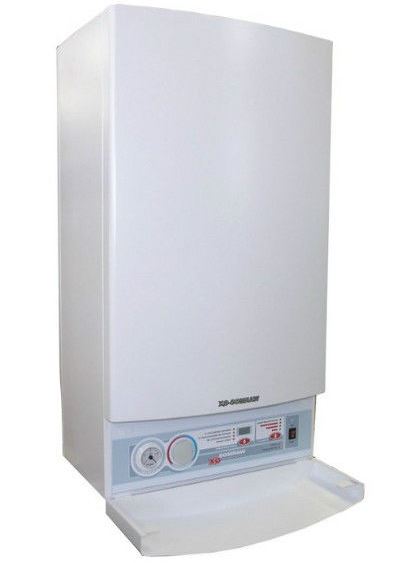

In the rating of electric boilers, it takes an honorable second place.By and large, this unit is a miniature boiler room, it is distinguished by domestic production, mechanical control, which is very easy to understand. It can be used for both residential and industrial premises, the boiler is equipped with a membrane-type expansion tank. It is designed for an area of up to 180 square meters.
The heating elements are made of stainless steel; water or antifreeze can be poured into the heating system. The device perfectly withstands voltage drops, phase imbalance. The set includes a remote programmer that allows you to put a weekly cycle of work in the device's memory. The boiler is absolutely safe due to the presence of a large number of different kinds of sensors: pressure, temperature, protection system against short circuits and overloads in the electrical network. The unit is very economical, equipped with light and sound alarms in case of malfunctions.
Benefits:
- Large volume of the expansion tank - 12 liters;
- Convenient access to the control panel;
- There is a built-in pump;
- It can work from both 220 V and 380 V;
- There is an emergency warning system;
- The control is mechanical, but all devices are electronic.
Disadvantages:
- It is advisable to connect through a stabilizer;
- Considerable weight;
- The capacitor is one of the most vulnerable points of the device.
EVAN EPO 6
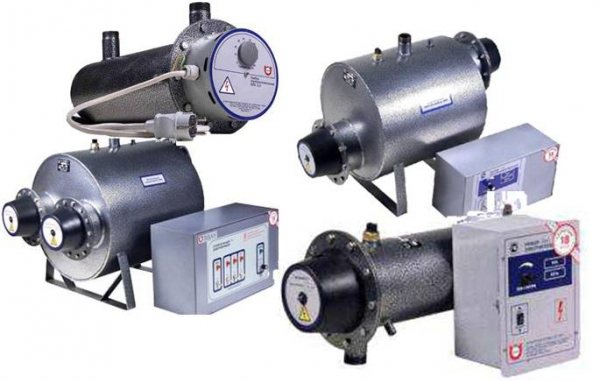

Well suited for heating large areas, it is characterized by high reliability, long service life and ease of use. The device works silently due to the original pumping system and a unique stainless steel housing. The unit can be used to heat country houses, therefore, it is permissible to fill in antifreeze, large industrial premises, and so on as a coolant.
The efficiency is 93% at a load of about 50% of the maximum power, the temperature is controlled smoothly, with an accuracy of a degree. You can additionally purchase the GSM-Climate module for remote control of equipment. There is a self-diagnosis system. For safe operation, the boiler is equipped with a thermostat, an emergency switch and other systems.
Benefits:
- Low cost and high reliability;
- Easy maintenance and installation.
Disadvantages:
- Not detected.
https://youtu.be/ib6srqUZ10w
# 1. The main types of boilers
Water heaters can be electric or gas. The latter are popularly called columns and are used less and less because of the increased danger. Electric water heaters are usually called boilers... They are familiar to many of us, they are distinguished by quiet operation, ease of use, durability and safety, if, of course, the choice was made correctly.
By the type of heating, electric water heaters are:
- flowing;
- accumulative.
Instantaneous electric water heaters
Boilers of this type are different compact size and allow you to heat the water instantly. Tap water, in contact with the heating element, is heated and enters the tap already hot, i.e. there is no mixing process with cold water. The water is heated instantly, since the power of the heating element is decent. Often, boilers of this type are used in apartments, where there are frequent interruptions with centralized hot water supply. They do an excellent job of heating water for one water intake point. If you turn on hot water in two places at the same time, it may not have time to warm up - it all depends on the power.
Instantaneous water heater power ranges from 3 to 27 kW. In an apartment with a single-phase voltage of 220 V, you cannot use an 8 kW boiler. A flow-through boiler with a capacity of 3-8 kW heats 2-6 liters of water per minute, which is not so little - this will be enough for the household and hygienic needs of a small family.
For a private house with a three-phase voltage of 380 V, you can take a more powerful boiler. Then there will definitely be no problems with a shortage of hot water.
Advantages of instantaneous boilers:
- compactness;
- fast heating of water;
- water is heated only when it is needed. Turned on the tap - warm water flows, turned off the tap - the water is not heated, which means that electricity is not consumed, which is the competitive advantage over storage boilers;
- the hot water will not run out suddenly. In storage boilers, if the hot water supply is used up, you will have to wait a long time for heating.
Minuses:
- high power turns sideways if the wiring in the house is not very good (for Khrushchevs and other old houses this is a serious problem), and even with frequent use of such a boiler, electricity bills will not please you. The storage boiler is more economical in this regard;
- water in a flow-through boiler can overheat, as it heats up very quickly, and does not mix with cold water. In this case, the boiler will first drain hot water, then warm, and then cold water will flow from the tap, and only then normal operation will resume. That is why it is very important that the boiler has a heating limiter.
Instantaneous water heaters can be of two types:
- gravity... Heats water only for one point of water intake, therefore it must be located in the immediate vicinity of it. For city apartments, this is not the most convenient option, but such a boiler is ideal for summer cottages;
- pressure... Such a water heater is built into the water riser, so the device allows you to heat water for several points of water intake at once.
Sometimes it is even possible to find on sale water heater tap, which can be considered the most simplified version of a non-pressure boiler.
Storage electric water heaters
In any case, the storage boiler will be larger than the flow boiler, since it is equipped with a tank in which the already heated water is heated and stored. When someone turns on the faucet, hot water from the boiler mixes with cold water and flows through a mixer or shower head. As the water is consumed or cools down, the appliance turns on heating again. Tank volume fluctuates from modest 10-30 liters to 150-200 liters... Such a water heater is installed on the wall or on the floor - it all depends on the size of the tank.
How much storage boiler volume is needed? It all depends on the needs of the family for hot water. To wash, on average, one person spends 40-50 liters of water, but keep in mind that hot water from a water heater is mixed with cold tap water. Taking a shower takes less water than taking a bath. When choosing the volume of the boiler you can focus on the following data:
- boiler volume 50-80 l enough for a small family of up to 3 people to wash the dishes and take a shower. In principle, you can take a bath if you heat the water in the boiler to the maximum;
- 80-100 l - option for a family of 4 people. Such a unit is not much more expensive than a 50-liter boiler, but a larger tank will heat up longer;
- 100-150 l - boiler for a large family, which consists of 6 people. There is enough water for several washbasins, for a shower, and for filling a bath;
- volume boilers more than 150 l they are used, as a rule, in private houses, are installed on the floor and consume a decent amount of electricity.
It is important not to miscalculate with volume. If it turns out to be insufficient, there will be constant inconveniences, and if it is excessive, then you will have to overpay and wait too long for heating.
Among the main advantages of storage boilers, we note:
- profitability. An average boiler, suitable for a city apartment, consumes 1.5-3 kW of electricity during heating and can be connected to a regular 220 V network;
- one boiler, even not of the largest volume, will be enough for the full provision of hot water to all water intake points in the apartment;
- durability.
The storage boiler immediately heats the entire volume of water in the tank, so the larger its capacity, the longer it will take to wait (a 30 liter tank will heat up in 1-1.5 hours, and a 120 liter tank will heat up to 4 hours). In addition, for huge water heaters, it is still necessary to find a suitable place. Usually, the boiler is located in a bathroom or toilet, so do not forget to take a tape measure before buying and measure how large the equipment can fit in the bathroom, so as not to interfere with free movement. Small-sized water heaters are produced not only in the usual vertical, but also in horizontal form. Some manufacturers produce embedded modelsthat can be placed in the cabinet under the sink.
Combined water heaters
This type of device combines the advantages of storage and instantaneous boilers. Combined water heaters, small in size, have a weight of no more than 6 kg, are equipped with a tank with a volume of 10-30 liters and can operate in two modes. The choice of such models is not very wide.
Can I use the boiler for heating
Modern water heaters can be used as a reliable source of heating for small, individually located residential buildings.
A boiler with a high thermal power in the range of 7-12 kW will be able to heat a private house building up to 100 m2 or a summer cottage.
This option of heat supply has its advantages and disadvantages, however, it completely copes with this option.
The positive point of the boiler for heating is that it can be installed by a home master with his own hands, provided that all the individual conditions for such a connection are met. An equally significant argument in favor of such a scheme is the availability of this type of heating at a price and a simple piping scheme.
Heating through a boiler
A water heater is an electric heater originally produced for domestic hot water supply. It is made in the form of a container, with an internal location of a thermal electric heating element - heating element.
There are designs in which a group of heating elements is installed from 2 to 3.
In order to understand whether such a device is capable of serving as a source of heating at home, it is necessary to consider the fundamental differences between a heating boiler and an electric boiler.
In the first version, when the water is heated, its natural circulation is carried out; for this, the corresponding inputs are made. Return cooled water from heating devices enters the boiler unit in the upper part of the structure, and is discharged through the supply pipes from below.
A boiler for heating a private house is structurally designed so that both pipes are located on the same side and this does not allow the coolant to move according to the principle of natural circulation.
Therefore, it is fundamentally important - to tie the boiler for heating in such a system with the use of a circulation pump, which will ensure the forced movement of water along the circuit.
Specifications
A boiler for heating a private house, which is supposed to be included in the heating circuit, must operate in a temperature range of 60-70 C and have a low thermal inertness of the system.
The latter characteristic directly depends on the type of heat exchanger and the electric power of the heating element. In containers up to 250 liters, heating is achieved in 1.5 - 2.5 hours. In addition, such water heating devices must operate from a 220 V household power supply.
, with a load not exceeding 30 - 40 A, so that a craftsman can connect the device on his own, without requiring a special permission from the RES.
Standard structural structure of a domestic water heater:
- A housing that protects functional elements from outside interference.
- A storage tank located in the middle of the structure, isolated from it by a heat insulator. The best volume for autonomous heating is considered to be devices from 150 to 300 liters.
- Heating element - heating element. It can be made in various design forms: rod, spiral and round.
- An essential characteristic for such boilers is thermal power. It should be from 7 to 12 kW, which will heat the room up to 120 m2.
- Inlet / outlet connections on the boiler for heating. Heating performance is determined by the rate of heat transfer, depending on the diameter of the outlet pipes. In hot water boilers, they usually have a cross section of up to 20 mm, and for the heating function, at least 32 mm is needed. In this case, the larger the diameter, the more efficiently the heating system functions. Of course, provided that the heat output of the heating element is sufficient.
- Controlling primary temperature sensors of the coolant integrated into the circuit of the circulation pump.
- Relay for monitoring the operation of the electrical network in order to protect the device from possible prolonged overloads.
Advantages and disadvantages of heating with an electric boiler
The main advantage of the scheme is its simplicity. Almost any master is capable of assembling such a structure, since for this purpose neither special qualifications nor complex tools are required. Another advantage is the low price.
Most often, electric water heaters for heating are sold at lower prices than electric boilers. Thanks to this, when creating a heat supply system for small objects, you can significantly save money.
At the same time, you can get a very reliable, highly functional system that can be controlled through modern communication lines, for example, Wi-Fi. That is why it integrates well into the Smart Home program.
The disadvantages of using water heaters include:
- Low power.
- The heating element is constantly in working order, which leads to rapid wear. To guarantee, you need to choose devices with 2 or more heating elements.
How does an electric water heater work for heating
As a rule, such devices are used exclusively for hot water supply. But modern technologies make it possible to use it as an additional heating circuit for heating water in a heating system. Before using a water heater to prepare the coolant of heating devices, it is necessary to modernize its make-up circuit:
Create a forced heating medium circulation circuit.
Perform piping of the heating circuit with the installation of mandatory protection and regulation devices: an expansion tank, a circulation electric pump and shut-off and control valves, a control and protection unit with primary sensors for temperature and pressure of the medium.
The originality of the idea, and its practical implementation, consists in the synchronous operation of the same source: for hot water supply and heating. For this reason, it is preliminarily recommended to select an electric pump of the required electrical power.
It must be able to cover all hydraulic losses in the system and distribute heat evenly over the heating devices.
Experts recommend that in systems of simultaneous heating of hot water supply and heating, provide for the installation of water purification filters at the inlet in front of the boiler.
Storage tank and boiler for heating
The storage tank, ultimately, is completely identical to the classic water heater. The difference lies in the internal coil, which is connected to the heating system.
A professionally organized heat supply system through a heat exchanger implies that this component will perform the function of a thermal accumulator. The liquid medium in the tank receives heat through a coil heat exchanger connected to the building's internal heating pipe system.
Indirect heating boiler
An optimal alternative to the heating option for small rooms is the inclusion of an indirect heating boiler in the heat supply circuit.They can be universal, capable of operating on different types of energy carriers: gas, flue gases from the combustion of solid fuels, and electricity.
Typically, such devices are installed in heat supply circuits to increase the overall efficiency in the form of an additional heating source. The traditional heating boiler is considered the main one. For the efficient operation of the indirect heating water heater, its installation is required before the return of the heating water is introduced into the boiler unit. In this way, it is possible to create an optimal heating system.
Do-it-yourself electric boiler for the heating system
The price of industrial modifications of heating water heaters is very high - from 12,000 to 70,000 rubles. and higher. Therefore, their alternative can be a self-made heater. For this case, it is allowed to use an arbitrary steel tank, of increased strength, with the parameters corresponding to the calculated ones.
To strap the heating circuits of a homemade water heater, you will need the following parts:
- Tank. It would be preferable to place an order from a specialized organization for a device made of non-corrosive steel or assemble it on your own. Holes must be positioned on the body in order to solder the inlet / outlet pipes.
- Coil heating element, copper is the best choice. This metal has the best heat transfer coefficient and temperature elasticity.
- Fasteners for piping heating and hot water systems.
- Safety automation with primary sensors and protective devices in the form of an air vent and an expansion tank. The set is purchased in the retail network according to the parameters of the working tank.
- Thermal protection of the boiler against thermal energy losses. For this, glass wool / basalt heat insulator of at least 5 cm is placed in the interlayer between the tank and the protective casing.
Installation of a boiler for heating
Installation of a heat supply circuit using a water heater in the form of a heating source is performed as follows:
- Choose a place and prepare it for installing a water heater. The site must have a flat horizontal surface with a size of at least 1x1 m.
- The foundation for structures with a volume of more than 200 liters is made of concrete, reinforced with reinforcement.
- Installation of the water heater structure is carried out in a strict vertical position.
- I install a circulating electric pump.
- Piping is performed. The outlet of the water heater for heating is connected to the electric pump, and the inlet is connected to the return.
- Locking and regulating equipment and sensors for monitoring the security system are installed.
- The device is connected to the power supply through a separate panel with an automatic device and an RCD.
- After assembling the circuit, perform a hydraulic pressure test of the heating system and check the operability of the electric heating circuit of the heating element.
Boiler for electric heating - instructions for use
Maintenance of electric boilers in heat supply systems is no different from performing the required operations for servicing the heating element. A boiler for heating will work well if you adhere to the following rules:
- Check the integrity of the unit's thermal insulation on a monthly basis.
- Observe the temperature difference of the coolant, it should not exceed 15-20 C.
- Check the tightness of pipe connections for leaks.
- Every year before the heating season, perform system maintenance with flushing of the internal circuit and replacement of gaskets.
- They monitor the operating parameters of the electrical network; in case of frequent failures in electrical lines, a stabilizer must be installed to preserve the electronic control unit.
To select the heating power from the boiler, they proceed from the calculation of 1 kW per 10 m2 of the heated room. This formula is well applicable in systems located in the central climatic region of Russia.
Next, you need to decide on the minimum volume of the tank.
Provided that the minimum level of accumulation capacity is 5 kW and the temperature difference between direct and return water is -20 C, the volume of the tank will be:
V = 5/20 = 0.25 m3 or 250 l
Overview of water heaters for electric heating
Manufacturers of heating devices already produce conventional boilers adapted for installation in heat supply networks. Their thermal power has been increased to 12 kW, in addition, they have increased diameters of inputs for connection in an internal heating system.
Heating from a boiler is not difficult to implement. Since such equipment is widely represented on the market, both by domestic and foreign manufacturers.
Their choice will depend on the required type of energy carrier and the type of heating: capacitive or indirect heating.
The latter are used more in autonomous heat supply schemes, so the principle applies here - the more, the better. They are well used during the heating season, and
in summer for hot water supply - it is wiser to use combined water heaters.
The most popular models of water heaters used in heating systems:
- Boiler for heating Thermex Champion Titaniumheat 150 V, production Russia, heating element, volume 150 l, price - 12190 rubles.
- Water heater for heating Gorenje TGU150NGB6, made in Serbia, heating element, volume 150 l, price - 14 320 rubles.
- Ariston ABS PRO R 150 V, made in Russia, heating element, volume 150 l, price - 14970 rubles.
- Bosch WSTB 200, made in Germany, indirect heating, volume 197 l, price - 40,833 rubles.
- Baxi Premier plus 150 (30 kW), made in Italy, indirect heating, volume 150 l, stainless steel tank price - 68,600 rubles.
- Buderus Logalux SU160 / 5 made in Germany, indirect heating “coil in coil”, stainless steel DUPLEX, volume 160 l, price - 68869 rubles.
Photos by text for clarity about what was said
Storage tank and electric boiler
Installation of an electric boiler in the heating circuit
Boiler Ariston ABS PRO R 150 V
Water heater model Thermex Champion Titaniumheat 150 V
Varieties of electric boilers for the heating system
Indirect heating boiler
Video links to text
Summing up, it can be said that a system using an electric boiler as a source of the heating system has its own pros and cons. Its main advantage is considered to be low specific consumption of electrical energy for heat generation and low cost of the wiring diagram.
Source: https://pechiexpert.ru/mozhno-li-ispolzovat-bojler-dlya-otopleniya/

